Celery root is a vegetable that has recently gained popularity in home kitchens.
It is commonly used to add flavor and texture to dishes from soups to salads.
But what if you don’t have access to this unique root? Are there other options to substitute for celery root?
Fortunately, the answer is yes – and we’ll be discussing some of these substitutes for celery root so that you can create tasty meals without having to shop around for something new!
What Is Celery Root?
Celery root, also known as celeriac, is a root vegetable that comes from the stalk of the celery plant.
It has an off-white bulbous shape and looks like a turnip with its rough exterior.
The inside of the root is white and crisp with a strong flavor that reflects both parsley and celery.
Celery root can be eaten raw or cooked and is often used in soups, stews, salads, and mashed dishes.
It’s also a popular addition to pestos and purees.
Its strong flavor makes it a great alternative to potatoes when preparing classic French dishes such as celery root remoulade or pommes Anna.
Additionally, its mild bitterness pairs well with herbs and spices, making it a great addition to curry dishes as well.
Due to its unique flavor profile and versatility, celery root is a popular vegetable in many cuisines around the world.

Substitutes For Celery Root
Celery root can be difficult to find or expensive. Fortunately, there are several alternatives that can work just as well in recipes.
Parsley
Parsley is a herb that belongs to the Apiaceae family of plants.
It has a mild, sweet flavor and can be used as a garnish or added to dishes for extra flavor.
Parsley is also known for its health benefits, such as being rich in vitamins A, C, K, and B6, antioxidants, and minerals such as calcium, iron, and potassium.
Parsley can be a great substitute for celery root in cooking because it has similar flavor notes but is much easier to find in the grocery store.
Additionally, parsley adds color and texture to dishes without adding too much sodium or other flavors.
Parsley is versatile enough to fit in with other herbs and spices to create flavorful dishes.
It’s also economical, as it can be purchased fresh or dried.

Fennel Bulb
The Fennel bulb, or Foeniculum vulgare, is a member of the Apiaceae family and is related to the celery root.
It has a sweet licorice-like fragrance and flavor that can be used as a substitute for celery in many dishes.
The entire plant (roots, stem, leaves, and bulb) can be used when cooking, adding a unique flavor to many dishes.
Fennel bulbs are typically white or pale green in color, with long stalks attached at the top. The leaves are feathery and light green in color.
The bulb is usually sweet and crunchy when eaten raw but can also be cooked and used in salads, soups, stews, roasts, or as a vegetable.
It can also be cut into slices and sautéed with other vegetables for increased flavor.
Fennel bulb contains vitamins A, C and K and dietary fiber.
Its licorice-like flavor makes it a great addition to many dishes, and its crunch and texture can make it a great substitute for celery root.

Daikon Radish
Daikon radish, also known as Japanese or Chinese radish, is a root vegetable native to East Asia.
It has a mild flavor and crunchy texture that make it a popular choice for many types of dishes.
Daikon radish can be used as an alternative to celery root in many recipes due to its similar texture and flavor.
It is also an excellent source of dietary fiber, Vitamin C, folate and potassium.
Daikon radish can be eaten cooked or raw in salads, stir-fries, soups, and much more.
It is an excellent vegetable to include in one’s diet, whether you are using it as a celery root substitute or not.
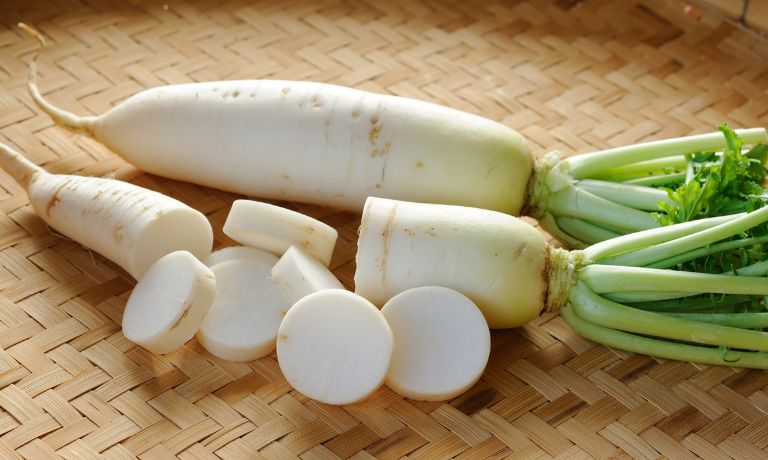
Butternut Squash
Butternut squash is a winter squash with an oblong shape and hard, sweet flesh.
The flesh is orange in color, and the skin is tan and tough.
It is packed with vitamins A and C, as well as dietary fiber.
It also contains several minerals, such as potassium, magnesium, iron, and zinc.
Its sweet flavor and creamy texture can be used as a substitute for celery root in many recipes.
It is an excellent ingredient for soups, stews, casseroles, baked dishes, side dishes, and desserts.
When baking with butternut squash, you may need to add more liquid ingredients or sugar to balance out its sweetness.
Butternut squash can be roasted, mashed, or pureed in sauces and dips.
As a vegetable, butternut squash is low in calories and fat, making it an ideal choice for health-conscious cooks.
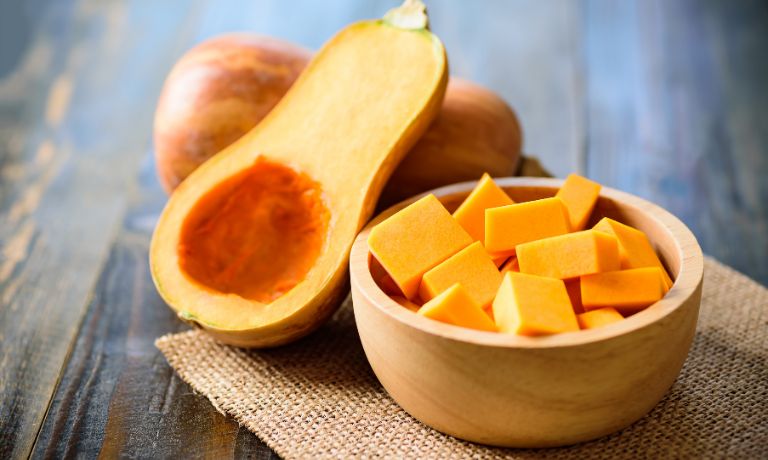
Parsnip
Parsnip is a vegetable resembling celery root in appearance, taste, and texture.
It can be used as a cooking alternative to celery root due to its flavor profile and versatility.
Parsnips have a sweet, nutty flavor with hints of licorice or anise similar to celery root.
It can be boiled, mashed, roasted, steamed, or used in soups and stews.
Parsnips are a great source of vitamins and minerals like potassium, magnesium, iron, folate, and vitamin C.
They are also low in calories and high in fiber, making them an excellent choice for health-conscious eaters.
Parsnips can replace celery root in recipes, offering the same flavors and versatility.
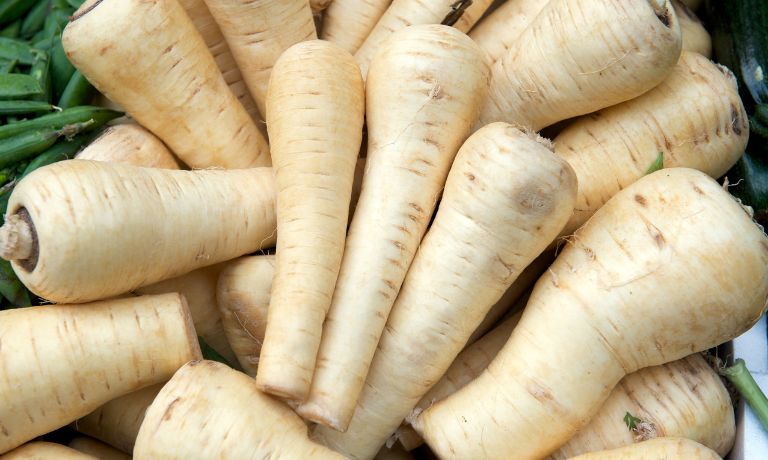
Carrot
Carrot is a root vegetable that can be found in many different varieties.
It is rich in vitamins and minerals, including Vitamin A, which helps promote good vision.
It also has vitamin C, folate, potassium, magnesium and other essential nutrients.
Carrot is an excellent substitute for celery root because it is much easier to cook.
Carrots can be boiled, steamed and even eaten raw in salads. It pairs well with other flavors such as garlic, ginger, nutmeg or curry powder.
Carrot is also a great addition to soups, stews and casseroles.
They are also relatively cheap and easy to find at most grocery stores, making them an ideal alternative to celery root in cooking.
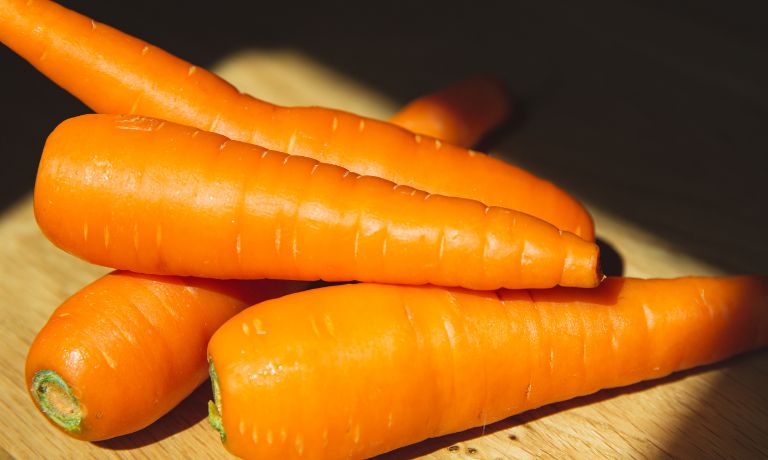
Turnip
Turnip, also known by its scientific name Brassica rapa, is a root vegetable used as a popular ingredient in many types of cuisine for centuries.
It can be eaten raw or cooked and has a mildly sweet flavor with hints of pepper.
Unlike celery root, turnip provides more crunch and texture to dishes.
It is also low in calories and contains good fiber, vitamin C, potassium, and other essential vitamins and minerals.
Turnip can be used as a substitute for celery root when preparing soups, stews, or sautés.
It provides moisture to the dish while adding flavor without overpowering other ingredients.
Turnip is also a great way to get more vegetables into your dish without adding extra calories.
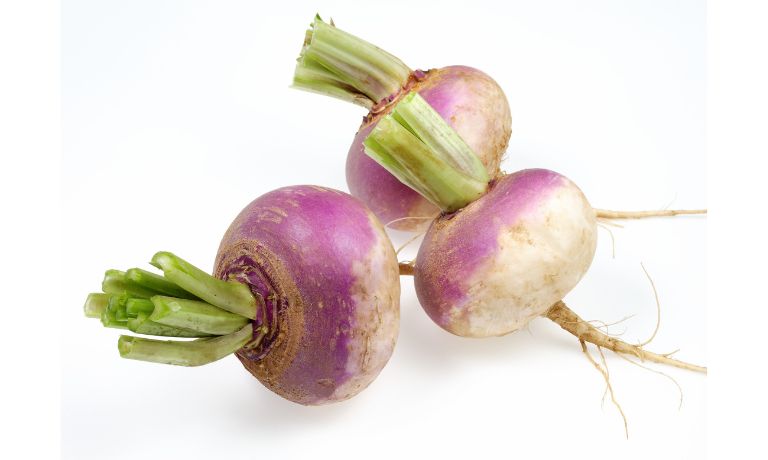
FAQs
Can I Swap Potatoes For Celery Root?
No, potatoes and celery root are not interchangeable in recipes. Celery root has a distinct flavor that cannot be replicated with potatoes.
Additionally, the texture of the two vegetables is very different, so they do not work well together in recipes.
What Root Vegetable Has A Celery-Like Flavor?
The root vegetable with a celery-like flavor is celeriac, also known as turnip-rooted celery or knob celery.
It looks like a large, off-white, knobby-skinned bulb with a mild celery-like taste.
Is Fennel The Same As Celery Root?
No, fennel and celery root are two different vegetables.
Fennel has a slightly sweet anise-like flavor with a crunchy texture, while celery root is milder in flavor and has a more earthy taste.
Conclusion
When looking for a substitute for celery root, there are many options.
Daikon radish, butternut squash, parsnip, fennel bulb and carrot are all excellent alternatives that can be used instead of celery root in various dishes.
Each vegetable offers its unique flavor and texture that can be used to transform any dish.
They are also low in calories and contain essential vitamins and minerals, making them ideal choices for health-conscious cooks.

